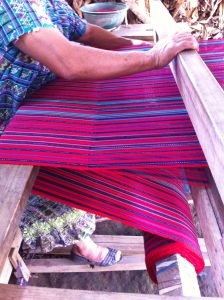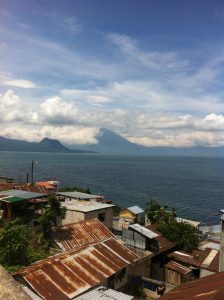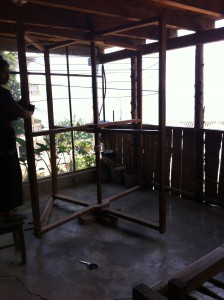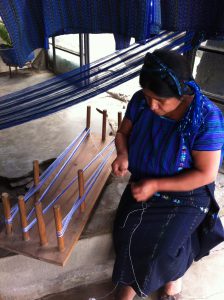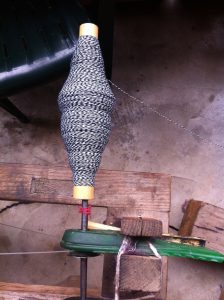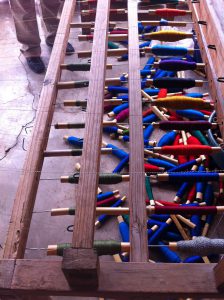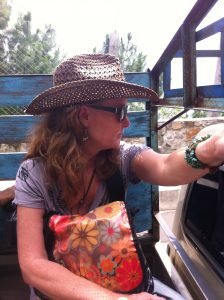
Kara Roguly
It is 6am on Sunday, I am in Panajachel on Lake Atitlan. A chorus of roosters, church bells and fireworks have become my alarm clock. I arrived in Guatemala six days ago, I leave from Antigua tomorrow.
I came to Guatemala to:
- Attend the New World Crafts Conference in Antigua;
- Work on product development with the producers who make Global Exchanges’ tire bags;
- Meet with artisan groups where Global Exchange sources Guatemalan woven products.
During the first part of my trip, I met with the artisans who make hand woven aprons for Global Exchange, in Xetonox outside of Antigua.
Then I moved on to San Antonio, 20 minutes outside of Panajachel on Lake Atitlan, to meet with the family where Global Exchange sources scarves.
Here’s more about my visit with the artisans in San Antonio:
Jennifer, an ex-pat from Canada, lives in Panajachel. She (like all ex-pats’s I have met on this trip) fell in love with the amazing grace and culture of the Mayan people while visiting almost 20 years ago.
Jennifer is Global Exchange’s connection to the artisans in San Antonio and my translator/guide for the day.
We met at her house. After breakfast we walked to the corner of the road and jumped in the back of a pick-up truck (pick-up trucks are used as taxi-buses around the lake) headed for San Antonio.
Jennifer knew which truck to get into by the way the women (in the back of the pick- up) were dressed. The majority of Mayan women in Guatemala wear traje, traditional indigenous clothing.The Mayan women from San Antonio wear bright indigo traje.
The truck dropped us off in front of San Antonio’s church, the last stop from Panajachel. The village of San Antonio rests in the side of a mountain and runs down to the docks of Lago de Atitlan.
I see vibrant color. Indigo traje’s, emerald green foliage and dark silhouettes of three volcanos protecting the deep blue of the lake.
The village itself is small and has little infrastructure. Homes are close together and are primarily made of concrete walls and metal roofs. The village is grey accented with burnt orange from rust.
Jennifer lead me down a small path off the main road, to meet Santos and his wife Candeleria.
Santos’ home/work space is different from the other homes in San Antonio. He built his home with wood beams and glass.They have a panoramic view (of the lake) in their main work/live space. It is open and lovely.
The main room has two foot looms (which men and women weave on) and one beam that supports a back strap loom (only women weave with a back strap). They live simply and work hard.
I spoke with Santos and Candeleria (Jennifer translated) about the process of weaving scarves. It goes like this.
1. Thread is bought by the pound then hand spooled into color blocked cones.
2. The cones are strategically organized by color to create a pattern for the foot loom prep. (women do the thread prep)
3. The organized cones are transferred to the foot loom prep (using a large square spool, the preparation is impressive and time consuming)
4. The prepped thread is then transferred to the foot loom, where Miguel begins to weave
When we arrive, Miguel, Rosario and Vivian are working on indigo scarves for Global Exchanges’ order.
Miguel is on the foot loom while the women are sewing final touches. Miguel (who is from San Antonio) is studying at a nearby university, and weaving enables him to pay for his education. Rosario (Candeleria’s sister) pays for her daughter’s education at the university thru weaving, and Vivian is studying eco-tourism at the university.
Global Exchange (paying Santos and Candeleria upfront) sells the beautiful, hand woven scarves in San Francisco and Berkeley shops.
We offer their scarves in indigo blue, harvest orange, crimson magenta and sage green. I see and feel the fair trade of this collaboration and know the direct impact our purchase has on this family.
I spent time with the weavers. Taking pictures, asking questions and watching their artwork magically come to life.
Sometimes the translation went from english to spanish to kaqchikel and back. At 11am Rosario stopped weaving to start making tortillas for lunch, and it was time to go.
Jen and I walked down to the Lake and on our return up to wait for the next pick-up back to “Pana” (in front of the Catholic Church) my stomach began to twist, so I bought a Sprite.
Perhaps it was the combination of foreign smells; car exhaust mixed with fragrant onions sitting in the sun, corn tortillas being made and wafts of sewage. Or guilt from thinking of how much I was looking forward to “getting back” to a hot shower.
Trying to calm my belly by slowly sipping carbonated sugar, I took a moment to reflect on the day. I thought about San Antonio’s simple way of life, the warmth of the people I met and the remarkable craft and cultural importance of Guatemalan weaving.
Looking out at the lake, over a sea of tin roofs tucked into a beautiful mountain of rich natural resources, I ask Jennifer what she sees, she replies “I see prosperity”.
I hope so.
This is my first time in Guatemala. It has been an eye-opening and life altering experience. Meeting the artisans has given real meaning to my definition of Fair Trade and a deeper connection and pride in my work.
I have many more photos and stories. Come into our shops, see these scarves for yourself and I can tell you more about my trip!

